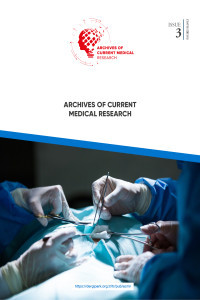Outcomes of Consultations to Burn Units from Emergency Service
Outcomes of Consultations to Burn Units from Emergency Service
Burns Consultation, Burn Treatment Center.,
___
- 1. Gibson JAG, Yarrow J, Brown L, Evans J, Rogers SN, Spencer S, et al. Identifying patient concerns during consultations in tertiary burns services: development of the Adult Burns Patient Concerns Inventory. BMJ Open. 2019;9(12):e032785.
- 2. American Burn Association. Burn Referral Criteria; Available at: https:// ameriburn.org/wp-content/uploads/2017/05/burncenterreferralcriteria.pdf Accessed: 20.07.2021
- 3. Bettencourt AP, Romanowski KS, Joe V, Jeng J, Carter JE, Cartotto R, et al. Updating the Burn Center Referral Criteria: Results From the 2018 eDelphi Consensus Study. J Burn Care Res. 2020;41(5):1052-1062.
- 4. Aviv U, Berl A, Haik J, Tessone A, Harats M. Standardization of Burn Patients Transfer: Implementation of a Transfer Request Form to Israel’s National Burn Center. Isr Med Assoc J. 2020;11(22):700-703.
- 5. Yastı AÇ, Şenel E, Saydam M, Özok G, Çoruh A, Yorgancı K. Guideline and treatment algorithm for burn injuries. Ulus Travma Acil Cerrahi Derg. 2015 Mar;21(2):79-89.
- 6. World Health Organisation. Global burden of disease. Switzerland: World Health Organization Press, 2004: 1–160 (e-book). Available at: https://www. who.int/healthinfo/global_burden_disease/GBD_report_2004update_full. pdf?ua. Accessed: July 20,2021.
- 7. Vogt PM, Busche MN. Evaluation of infrastructure, equipment and training of 28 burn units/burn centers in Germany, Austria and Switzerland. Burns. 2011;37(2):257-64.
- 8. Van Yperen DT, Van Lieshout EMM, Nugteren LHT, Plaisier AC, Verhofstad MHJ, Van der Vlies CH, et al. Adherence to the emergency management of severe burns referral criteria in burn patients admitted to a hospital with or without a specialized burn center. Burns. 2021 Mar 1:S0305-4179(21)00059-0.
- 9. Brusselaers N, Monstrey S, Vogelaers D, Hoste E, Blot S. Severe burn injury in Europe: a systematic review of the incidence, etiology, morbidity, and mortality. Crit Care. 2010;14(5):R188.
- 10. The Official Gazette, 8 October 2019, Number:30912 Ministry of Health, Legislation about Burnt Treatment Units. Available at: https://www. resmigazete.gov.tr/eskiler/2019/10/20191008-1.htm.Accessed: July 20,2021.
- Yayın Aralığı: Yılda 3 Sayı
- Başlangıç: 2020
- Yayıncı: 14 Mart Tıbbiyeliler Derneği
Muhammet Salih AYAS, Kerim ÖNER
Analyzing Electrocardiography Abnormalities in COVID-19 Patients Admitting to Emergency Department
Miray TÜMER, Ahmet Burak ERDEM, Hakan OĞUZTÜRK, Selahattin GÜRÜ, Gulhan KURTOGLU CELİK, Afşin Emre KAYIPMAZ
Uğur KÜÇÜK, Emine GAZİ, Bahadır KIRILMAZ
Ideal Surgery Time in COVID-19 Process: A Case Report of Pulmonary Hydatid Cyst in Covid Patient
Gökhan AYTEKİN, Fatih ÇÖLKESEN, Eray YILDIZ, Şevket ARSLAN, Ahmet ÇALIŞKANER
Depression, Occupational Anxiety, and Related Factors in Medical Students
Emergency major surgery in thoracic trauma: Timing and decision process
Eray ÇINAR, Kubilay İNAN, Ozgur Omer YİLDİZ
Non-Surgical Treatment Options for Peyronie’s Disease
Damla ÇINAR, Sedanur SARI, Hüseyin ALKAN, Kübra Buket AY, Enes BORCAKTEPE, Ahmet Yiğit DUYUM, Sude Sevcan FİLİKÇİ, Eren GENÇER, Çağla SENEM, Serhat SOYLU, Şeyma TUNA, Rabia TUNCER, Mehmet Emin YAZICI, Emre ALTINTAŞ, Murat GÜL
Abduction Orthosis in Treatment of Primary Acetabular Dysplasia: Results of Three Years Follow-up
Sinan YÜKSEL, Serhan ÜNLÜ, Onder ERSAN, Faruk CATMA, Yenel Gurkan BİLGETEKİN, Kürşat Reşat DEMİR
Ahmet KARAYİĞİT, Hayrettin DİZEN, Ümit ÖZDEMİR, Dursun Burak ÖZDEMİR, İhsan Burak KARAKAYA, İlter OZER, Bülent ÜNAL, Murat ULAŞ
